The March Brown wet fly (MBWF) is a great imitation of early-season up-winged flies as they emerge. For example, large dark olives (Baëtis Rhodani), March Brown (Rhithrogena Germanica), and Large Brook Dun (Ecdyonurus Torrentis).
The pattern I fish is a subtle variation of the all-time classic wet fly, the origin of which goes back many years. Fished on rivers, it’s…
deadly then trout refuse to take the dry fly.
In addition to being an excellent fly for catching brown trout, I’ve caught plenty of Welsh Dee sea trout fishing in the evening.
How to tie the March Brown wet fly
Material list:
- Hook: #16 & 14 Kamasan 402
- Thread: Rusty brown 8/0 Uni-Thread
- Body: WAPSI fox squirrel dubbing
- Rib: Gold wire
- Hackle: Brown partridge neck
- Wing: Ostrich wing feather slips
Step-by-step instructions:
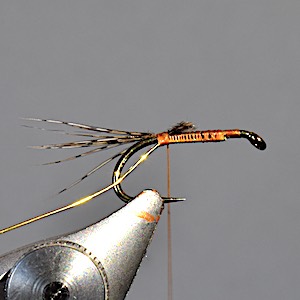
Step 1. With the hook locked in the vice, start the rusty brown 8/0 thread at the head. Tie in the gold wire and take the thread in touching turns towards the bend. Opposite the barb, tie in the partridge tail.
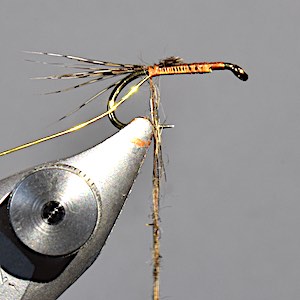
Step 2. Wax the rusty brown thread. Then, take a small pinch of the fox squirrel dubbing and lightly dub the thread.
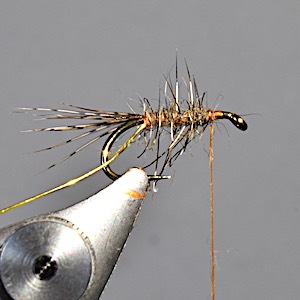
Step 3. Wind the dubbed thread forward, stopping 2 mm from the eye. I prefer to tie the March Brown wet fly with a slim body profile.
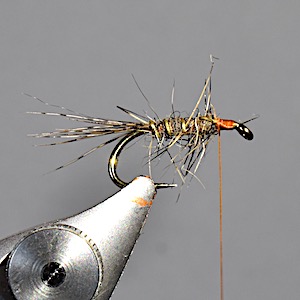
Step 4. Wind the gold wire forward in about 4 turns and tie it off with the thread. Apply more wax before tying in the hackle in the next step.
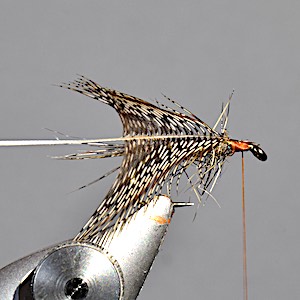
Step 5. Take a brown partridge feather, hold it by the tip and stroke the fibres backwards. The fibres should be long enough to extend just past the hook point when tied in. Using the waxed thread, tie down the feather with the upper side facing.
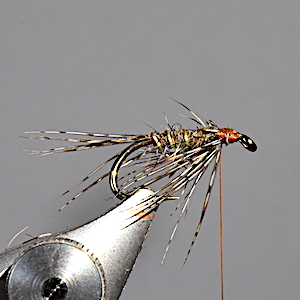
Step 6. Using a pair of hackle pliers, make 2 turns of hackle, trap the quill with the thread, and trim the waste. To form the legs, separate the hackle evenly on both sides, and with your thumb and forefinger stroke the fibres back away from the eye and below the shank. Hold it in place and take several wraps of thread over the fold to hold in place.
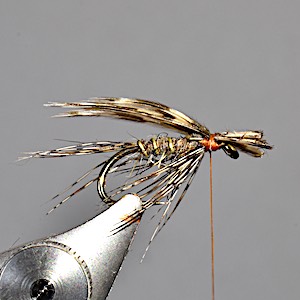
Step 7. Take a left and right Ostrich secondary wing feather. Remove a slip of equal width from each quill. Place the two slips together with the dull side facing inwards. Align the wing along the body, so it extends just past the bend and tie it in.
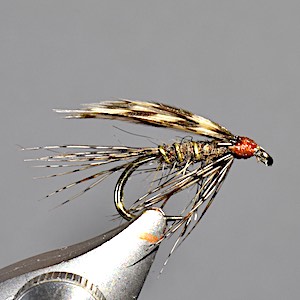
Step 8. Finally, form a small head with the thread, whip finish, apply varnish to the head, and with a dubbing needle ensure the hook eye is free of varnish.
Fly fishing tips for March Brown wet fly (MBWF)
On wild rain-fed rivers and streams, wet fly fishing is often the best approach when it’s difficult to see fish rising or see the dry fly on the surface. Also, if trout refuse to take the dry fly, I switch to wet fishing.
Early in the trout season, one of my favourite teams of wet flies/nymphs consists of MBWF (top dropper), MB spider (middle dropper), and pheasant tail nymph (point fly).
For wet fly fishing, I use a 9ft 5# rod, a floating line, and a 9ft 5X copolymer leader, which has been cut back to 5ft from the butt end. At the end of the leader, I tie on two 3ft lengths of 3lb copolymer to form 2 droppers.
It is important to degrease the leader with fuller earth to ensure it sinks.
Finally, I hope this article stimulates you to tie the March Brown wet fly and test it on your local river or take a trip to fish the Welsh Dee on a day ticket beat, where it catches plenty of spring brown trout.
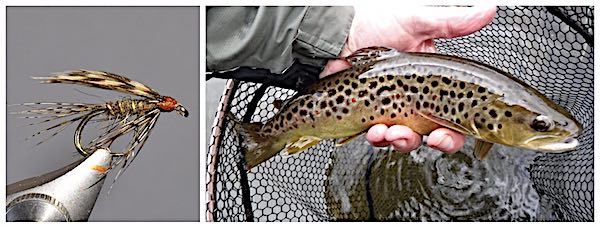
Lovely looking fly would you fish it upstream or down and across. It’s got a look of fry about it as well don’t you think
Hi James,
If you can it’s best to fish it upstream. However, when you have no option it does fish well across and down with regular mends in the line to slow the swing. I’m sure in the evening the fly is mistaken for fry especially in the margins of slower pools.
Cheers, Andrew
An iconic fly in it’s many variations that catches trout! Always welcome in my fly box!
Another iconic and very productive pattern. Your step by step photographs are very helpful and the commentary is precise. I am greatly enjoying your posts. I have been fly fishing and tying flies since I was eleven (and am now 75) and yet I feel I am learning or at least seeing patterns and techniques in a different and valuable light in your presentations. Many thanks from far across the pond.
Hi Paul,
Thanks for the feedback on the post – it’s great to hear you’ve found the fly tying guides very informative.
I’ve only had a mere 40 years of practice tying flies and I’m still learning new things on a daily basis – and long may it continue.
Cheers, Andrew
very nice tying as usual .spot on
Thanks
Thanks Andrew
But what of your weighted version? When and how does that see the water? All your blogs, tips and advice are appreciated. Thank you!
Rod.
.
Hi Rod,
I normally fish the March brown wet fly on the top dropper in the surface film when trout seem to refuse the dry fly. The weighted March Brown spider is fished on the point of a team of three wet flies. It is often taken when the flies swing around to the dangle and rises towards the surface.
I hope this helps, Andrew
I’ve been fly-fishing for 60 years and still learning.
This is another great fly which I can’t wait to try on my home river, the Derwent at Cockermouth and on the Annan. Thanks
Hi Steve,
It’s great to hear you enjoyed the post and it would be great to know if it brings you success on the Annan.
Have to agree there are always things to learn.
Tight lines, Andrew